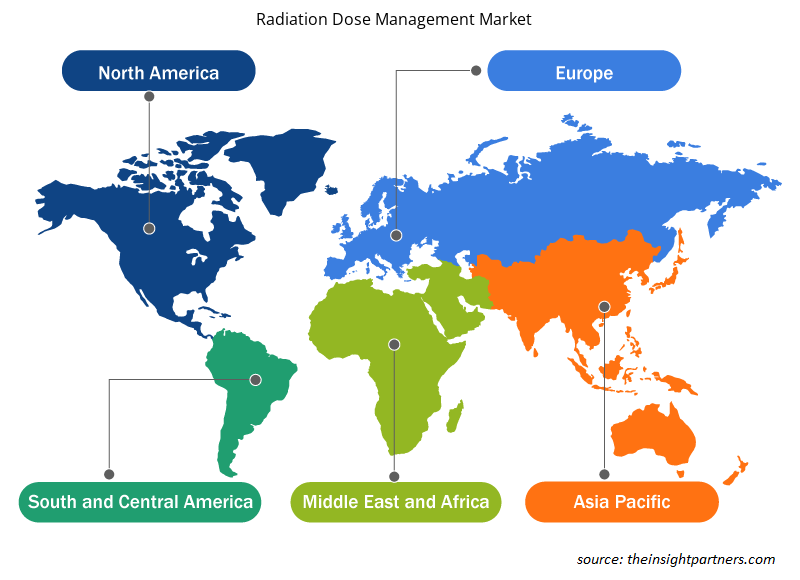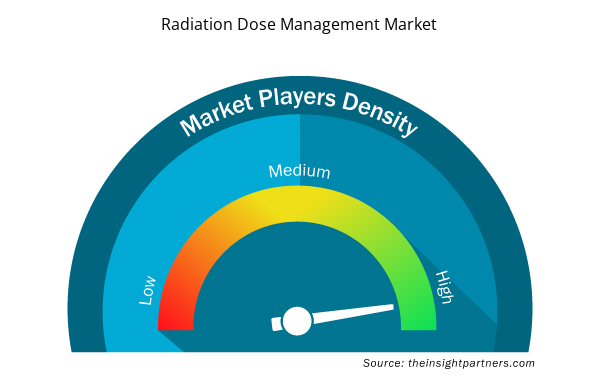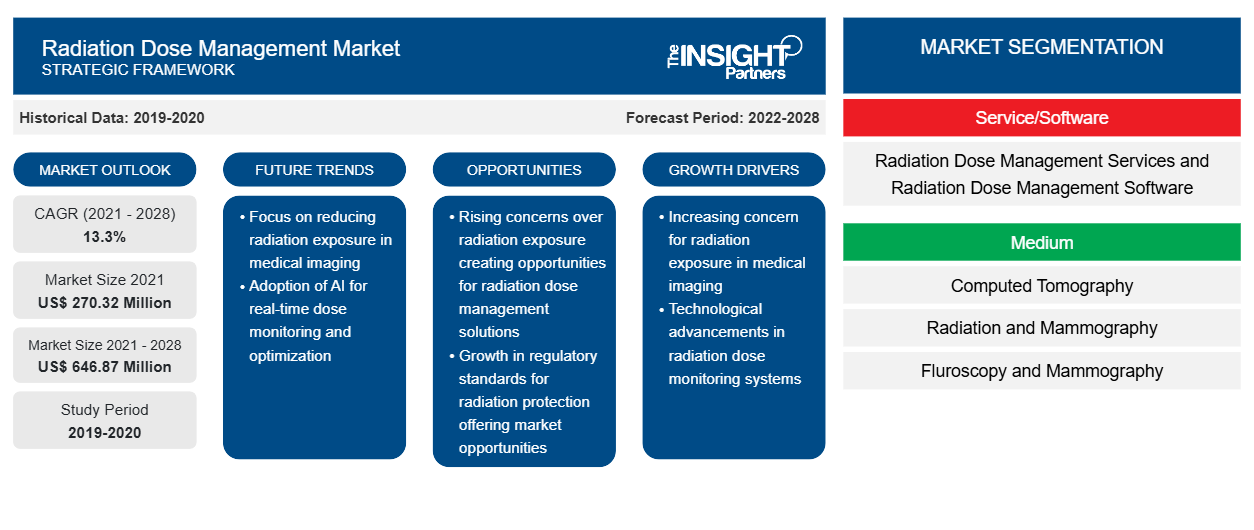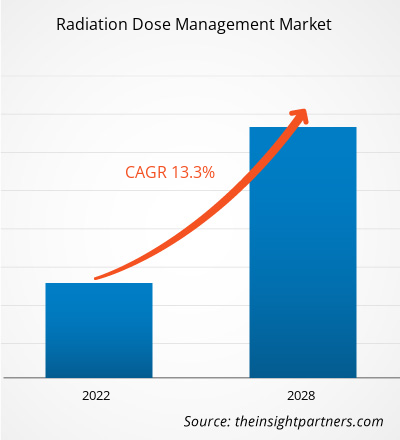Der Markt für Strahlendosismanagement soll von 270,32 Millionen US-Dollar im Jahr 2021 auf 646,87 Millionen US-Dollar im Jahr 2028 anwachsen; für den Zeitraum 2021–2028 wird mit einer durchschnittlichen jährlichen Wachstumsrate von 13,3 % gerechnet.
Strahlentherapie ist ein wichtiger Zweig der Medizin. Verschiedene Krankheiten wie Krebs, Herz-Kreislauf-Erkrankungen usw. werden durch elektromagnetische Wellen diagnostiziert und behandelt. Sie wird häufig zur Behandlung verschiedener Krebsarten eingesetzt. Strahlentherapie hat jedoch auch Nebenwirkungen. Daher ist die Überwachung der richtigen Strahlendosis bei jedem strahlenbasierten medizinischen Verfahren äußerst wichtig. Die Strahlendosis ist die Menge an Strahlung, der der Patient ausgesetzt ist. Das Strahlendosismanagement umfasst Informationen zu Strahlungsdosisaufzeichnungssoftware, Echtzeit-Dosisüberwachung des Personals, Einhaltung gesetzlicher Vorschriften und Technologien zur Dosisreduzierung, wie z. B. interaktive Rekonstruktionssoftware.
Das Wachstum des Marktes für Strahlendosismanagement ist auf die zunehmende Besorgnis im Zusammenhang mit Strahlenbelastung und die steigende Zahl von Krebserkrankungen zurückzuführen, die eine Strahlentherapie erfordern. Die organisatorischen Herausforderungen und das Fehlen von Benchmarking zur Dosisoptimierung hemmen jedoch das Marktwachstum.
Passen Sie diesen Bericht Ihren Anforderungen an
Sie erhalten kostenlos individuelle Anpassungen an jedem Bericht, einschließlich Teilen dieses Berichts oder einer Analyse auf Länderebene, eines Excel-Datenpakets sowie tolle Angebote und Rabatte für Start-ups und Universitäten.
- Holen Sie sich die wichtigsten Markttrends aus diesem Bericht.Dieses KOSTENLOSE Beispiel umfasst eine Datenanalyse von Markttrends bis hin zu Schätzungen und Prognosen.
Markteinblicke
Interventionelle Radiologie und Nuklearmedizin rücken immer stärker in den Fokus
Schnelle Fortschritte in der Medizintechnik, der Geräteherstellung und der Bildgebungsausrüstung haben zur Verfeinerung ursprünglicher Verfahren durch bessere Techniken und zu einer Erweiterung der Indikationen für Verfahren geführt. Neue Techniken wurden entwickelt und einige Techniken wurden auf andere Bildgebungsmodalitäten übertragen. Aufgrund der hohen Bildgebungseffizienz werden weltweit mehr interventionelle radiologische und nuklearmedizinische Verfahren durchgeführt. Laut der Society of Nuclear Medicine werden in den USA jedes Jahr etwa 20 Millionen nuklearmedizinische Verfahren durchgeführt. Laut Angaben der World Nuclear Association verwenden weltweit mehr als 10.000 Krankenhäuser Radioisotope in der Medizin und 90 % der Radioisotopenverfahren sind diagnostisch. Marktteilnehmer wie Bayer Healthcare und Sectra Medical Systems bieten Dosismanagementsoftware speziell für RDM in der interventionellen Bildgebung und Nuklearmedizin an. Daher bietet der wachsende Fokus auf die interventionelle Radiologie und Nuklearmedizin Chancen für das Wachstum des Marktes.
Service-/Softwarebasierte Einblicke
Basierend auf Service/Software wurde der globale Markt für Strahlendosismanagement in Strahlendosismanagementdienste und Strahlendosismanagementsoftware segmentiert. Das Segment der Strahlendosismanagementsoftware hatte 2021 den größten Marktanteil und wird im Prognosezeitraum voraussichtlich eine durchschnittliche jährliche Wachstumsrate (CAGR) von 13,6 % verzeichnen.
Medienbasierte Einblicke
Basierend auf dem Medium ist der globale Markt für Strahlendosismanagement in Computertomographie, Strahlung und Mammographie, Fluoroskopie und Mammographie und andere Medien unterteilt. Das Segment Computertomographie hatte 2021 den größten Marktanteil und wird im Prognosezeitraum voraussichtlich eine durchschnittliche jährliche Wachstumsrate (CAGR) von 13,8 % verzeichnen.
Regionale Einblicke in den Markt für Strahlendosismanagement
Die regionalen Trends und Faktoren, die den Markt für Strahlendosismanagement im Prognosezeitraum beeinflussen, wurden von den Analysten von Insight Partners ausführlich erläutert. In diesem Abschnitt werden auch die Marktsegmente und die Geografie des Strahlendosismanagements in Nordamerika, Europa, im asiatisch-pazifischen Raum, im Nahen Osten und Afrika sowie in Süd- und Mittelamerika erörtert.

- Erhalten Sie regionale Daten zum Markt für Strahlendosismanagement
Umfang des Marktberichts zum Strahlendosismanagement
| Berichtsattribut | Details |
|---|---|
| Marktgröße im Jahr 2021 | 270,32 Millionen US-Dollar |
| Marktgröße bis 2028 | 646,87 Millionen US-Dollar |
| Globale CAGR (2021 - 2028) | 13,3 % |
| Historische Daten | 2019-2020 |
| Prognosezeitraum | 2022–2028 |
| Abgedeckte Segmente | Nach Service/Software
|
| Abgedeckte Regionen und Länder | Nordamerika
|
| Marktführer und wichtige Unternehmensprofile |
|
Dichte der Marktteilnehmer im Bereich Strahlendosismanagement: Die Auswirkungen auf die Geschäftsdynamik verstehen
Der Markt für Strahlendosismanagement wächst rasant, angetrieben durch die steigende Nachfrage der Endnutzer aufgrund von Faktoren wie sich entwickelnden Verbraucherpräferenzen, technologischen Fortschritten und einem größeren Bewusstsein für die Vorteile des Produkts. Mit steigender Nachfrage erweitern Unternehmen ihr Angebot, entwickeln Innovationen, um die Bedürfnisse der Verbraucher zu erfüllen, und nutzen neue Trends, was das Marktwachstum weiter ankurbelt.
Die Marktteilnehmerdichte bezieht sich auf die Verteilung der Firmen oder Unternehmen, die in einem bestimmten Markt oder einer bestimmten Branche tätig sind. Sie gibt an, wie viele Wettbewerber (Marktteilnehmer) in einem bestimmten Marktraum im Verhältnis zu seiner Größe oder seinem gesamten Marktwert präsent sind.
Die wichtigsten auf dem Markt für Strahlendosismanagement tätigen Unternehmen sind:
- FUJIFILM Holdings Corporation
- Bayer AG
- Bracco Imaging SpA
- GE-Gesundheitswesen
- Koninklijke Philips NV
Haftungsausschluss : Die oben aufgeführten Unternehmen sind nicht in einer bestimmten Reihenfolge aufgeführt.

- Überblick über die wichtigsten Akteure auf dem Markt für Strahlendosismanagement
Endbenutzerbasierte Erkenntnisse
Basierend auf dem Endverbraucher ist der Markt für Strahlendosismanagement in Krankenhäuser, Forschungs- und medizinische Institute und andere segmentiert. Das Krankenhaussegment hielt 2021 den größten Marktanteil und wird im Prognosezeitraum voraussichtlich die höchste durchschnittliche jährliche Wachstumsrate (CAGR) von 13,6 % auf dem Markt verzeichnen.
Produkteinführungen und -zulassungen sind häufig von Unternehmen angewandte Strategien, um ihre globale Präsenz und ihr Produktportfolio zu erweitern. Darüber hinaus konzentrieren sich die Akteure auf dem Markt für Strahlendosismanagement auf die Partnerschaftsstrategie, um ihren Kundenstamm zu erweitern, was ihnen wiederum ermöglicht, ihren Markennamen weltweit aufrechtzuerhalten.
Firmenprofile
- FUJIFILM Holdings Corporation
- Bayer AG
- Bracco Imaging SpA
- GE-Gesundheitswesen
- Koninklijke Philips NV
- Medsquare
- Novarad Corporation
- QAELUM INC
- Sectra AB
- PACSHealth, LLC
- Historische Analyse (2 Jahre), Basisjahr, Prognose (7 Jahre) mit CAGR
- PEST- und SWOT-Analyse
- Marktgröße Wert/Volumen – Global, Regional, Land
- Branche und Wettbewerbsumfeld
- Excel-Datensatz



Report Coverage
Revenue forecast, Company Analysis, Industry landscape, Growth factors, and Trends

Segment Covered
This text is related
to segments covered.

Regional Scope
North America, Europe, Asia Pacific, Middle East & Africa, South & Central America

Country Scope
This text is related
to country scope.
Häufig gestellte Fragen
The Radiation Dose Management software segment dominated the global radiation dose management market and held the largest revenue share of 77.67% in 2021.
Radiation dose management involves services and software that keep records of the radiation doses, real time dose monitoring, regulatory compliance. It is an information technology which is considerate in lowering the dose with integrative reconstruction software. The software assists to find the right way to radiation dose for a patient to get treated by the integration of medical technology and insightful data & services.
Key factors that are driving the growth of this market are growing concerns related to radiation exposure, and rising cases of cancer demanding radiation therapy.
The Computed Tomography segment dominated the global radiation dose management market and held the largest revenue share of 42.54% in 2021.
The hospitals segment dominated the global radiation dose management market and accounted for the largest revenue share of 51.14% in 2021.
Global radiation dose management market is segmented by region into North America, Europe, Asia Pacific, Middle East & Africa and South & Central America. In North America, the U.S. is the largest market for radiation dose management. The market growth in the country is attributed to the factors such as the stringent legislative and accreditation requirements regarding the reporting and optimization of radiation doses, high adoption of HCIT technologies, and the presence of stringent regulatory requirements regarding patient safety. And, North America is the fastest-growing region growing at the CAGR of 13.8% during the forecast period.
The radiation dose management market majorly consists of the players such as FUJIFILM Holdings Corporation; Bayer AG; Bracco Imaging S.p.A; GE Healthcare; Koninklijke Philips N.V.; Medsquare; Novarad Corporation; QAELUM INC; Sectra AB; PACSHealth, LLC: among others.
Trends and growth analysis reports related to Technology, Media and Telecommunications : READ MORE..
List of Companies - Radiation Dose Management Market
- FUJIFILM Holdings Corporation
- Bayer AG
- Bracco Imaging S.p.A
- GE Healthcare
- Koninklijke Philips N.V.
- Medsquare
- Novarad Corporation
- QAELUM INC
- Sectra AB
- PACSHealth, LLC
The Insight Partners performs research in 4 major stages: Data Collection & Secondary Research, Primary Research, Data Analysis and Data Triangulation & Final Review.
- Data Collection and Secondary Research:
As a market research and consulting firm operating from a decade, we have published and advised several client across the globe. First step for any study will start with an assessment of currently available data and insights from existing reports. Further, historical and current market information is collected from Investor Presentations, Annual Reports, SEC Filings, etc., and other information related to company’s performance and market positioning are gathered from Paid Databases (Factiva, Hoovers, and Reuters) and various other publications available in public domain.
Several associations trade associates, technical forums, institutes, societies and organization are accessed to gain technical as well as market related insights through their publications such as research papers, blogs and press releases related to the studies are referred to get cues about the market. Further, white papers, journals, magazines, and other news articles published in last 3 years are scrutinized and analyzed to understand the current market trends.
- Primary Research:
The primarily interview analysis comprise of data obtained from industry participants interview and answers to survey questions gathered by in-house primary team.
For primary research, interviews are conducted with industry experts/CEOs/Marketing Managers/VPs/Subject Matter Experts from both demand and supply side to get a 360-degree view of the market. The primary team conducts several interviews based on the complexity of the markets to understand the various market trends and dynamics which makes research more credible and precise.
A typical research interview fulfils the following functions:
- Provides first-hand information on the market size, market trends, growth trends, competitive landscape, and outlook
- Validates and strengthens in-house secondary research findings
- Develops the analysis team’s expertise and market understanding
Primary research involves email interactions and telephone interviews for each market, category, segment, and sub-segment across geographies. The participants who typically take part in such a process include, but are not limited to:
- Industry participants: VPs, business development managers, market intelligence managers and national sales managers
- Outside experts: Valuation experts, research analysts and key opinion leaders specializing in the electronics and semiconductor industry.
Below is the breakup of our primary respondents by company, designation, and region:

Once we receive the confirmation from primary research sources or primary respondents, we finalize the base year market estimation and forecast the data as per the macroeconomic and microeconomic factors assessed during data collection.
- Data Analysis:
Once data is validated through both secondary as well as primary respondents, we finalize the market estimations by hypothesis formulation and factor analysis at regional and country level.
- Macro-Economic Factor Analysis:
We analyse macroeconomic indicators such the gross domestic product (GDP), increase in the demand for goods and services across industries, technological advancement, regional economic growth, governmental policies, the influence of COVID-19, PEST analysis, and other aspects. This analysis aids in setting benchmarks for various nations/regions and approximating market splits. Additionally, the general trend of the aforementioned components aid in determining the market's development possibilities.
- Country Level Data:
Various factors that are especially aligned to the country are taken into account to determine the market size for a certain area and country, including the presence of vendors, such as headquarters and offices, the country's GDP, demand patterns, and industry growth. To comprehend the market dynamics for the nation, a number of growth variables, inhibitors, application areas, and current market trends are researched. The aforementioned elements aid in determining the country's overall market's growth potential.
- Company Profile:
The “Table of Contents” is formulated by listing and analyzing more than 25 - 30 companies operating in the market ecosystem across geographies. However, we profile only 10 companies as a standard practice in our syndicate reports. These 10 companies comprise leading, emerging, and regional players. Nonetheless, our analysis is not restricted to the 10 listed companies, we also analyze other companies present in the market to develop a holistic view and understand the prevailing trends. The “Company Profiles” section in the report covers key facts, business description, products & services, financial information, SWOT analysis, and key developments. The financial information presented is extracted from the annual reports and official documents of the publicly listed companies. Upon collecting the information for the sections of respective companies, we verify them via various primary sources and then compile the data in respective company profiles. The company level information helps us in deriving the base number as well as in forecasting the market size.
- Developing Base Number:
Aggregation of sales statistics (2020-2022) and macro-economic factor, and other secondary and primary research insights are utilized to arrive at base number and related market shares for 2022. The data gaps are identified in this step and relevant market data is analyzed, collected from paid primary interviews or databases. On finalizing the base year market size, forecasts are developed on the basis of macro-economic, industry and market growth factors and company level analysis.
- Data Triangulation and Final Review:
The market findings and base year market size calculations are validated from supply as well as demand side. Demand side validations are based on macro-economic factor analysis and benchmarks for respective regions and countries. In case of supply side validations, revenues of major companies are estimated (in case not available) based on industry benchmark, approximate number of employees, product portfolio, and primary interviews revenues are gathered. Further revenue from target product/service segment is assessed to avoid overshooting of market statistics. In case of heavy deviations between supply and demand side values, all thes steps are repeated to achieve synchronization.
We follow an iterative model, wherein we share our research findings with Subject Matter Experts (SME’s) and Key Opinion Leaders (KOLs) until consensus view of the market is not formulated – this model negates any drastic deviation in the opinions of experts. Only validated and universally acceptable research findings are quoted in our reports.
We have important check points that we use to validate our research findings – which we call – data triangulation, where we validate the information, we generate from secondary sources with primary interviews and then we re-validate with our internal data bases and Subject matter experts. This comprehensive model enables us to deliver high quality, reliable data in shortest possible time.


 Holen Sie sich ein kostenloses Muster für diesen Bericht
Holen Sie sich ein kostenloses Muster für diesen Bericht